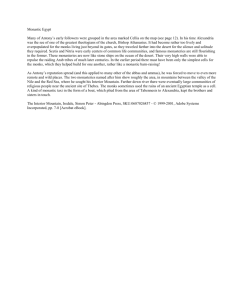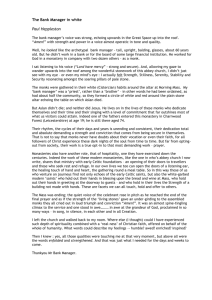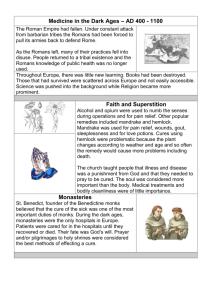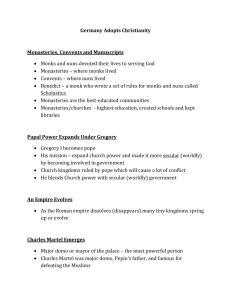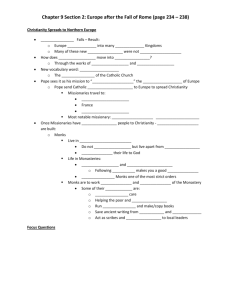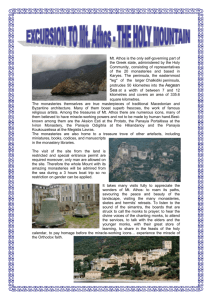Monasteries Reading
advertisement
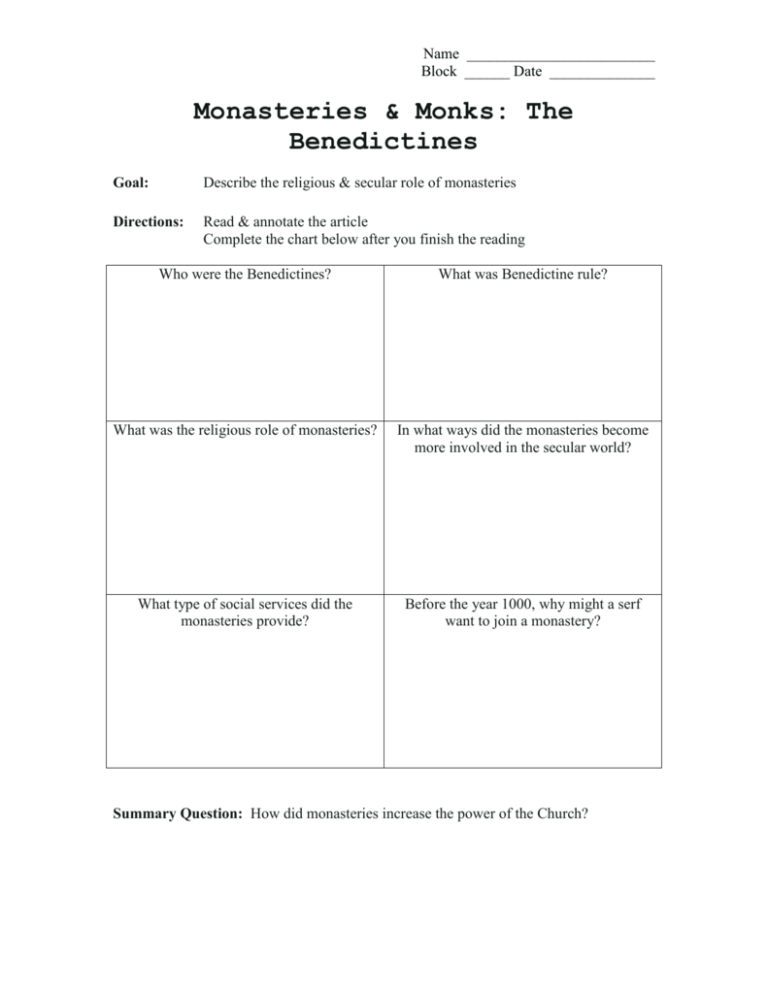
Name _________________________ Block ______ Date ______________ Monasteries & Monks: The Benedictines Goal: Describe the religious & secular role of monasteries Directions: Read & annotate the article Complete the chart below after you finish the reading Who were the Benedictines? What was Benedictine rule? What was the religious role of monasteries? In what ways did the monasteries become more involved in the secular world? What type of social services did the monasteries provide? Before the year 1000, why might a serf want to join a monastery? Summary Question: How did monasteries increase the power of the Church? Monasteries & Monks: The Benedictines The Benedictines were the oldest order of monks in Western Europe during the Middle Ages. They followed Benedict of Nursia's Benedictine Rule, written in the mid-sixth century and based upon monastic experience in the Eastern Roman Empire. The rule, or constitution, was intended to be flexible and moderate, so that each monk could glorify God and achieve his own individual salvation. By 800, the Benedictine Rule dominated all other monastic rules in Western Europe. Benedict had established his original monastery at Monte Cassino in Italy ca. 530. His original group of followers were laymen seeking to escape the world. The monks made vows of stability, reformation of life, and obedience. A daily routine was fixed for the monks, with a balance between work and prayer and moderation in all things as its guiding light. Benedict intended for the monastery to be self-supporting in order to minimize contact with the outside world. Contemporary observers referred to Benedictines as the "black monks" because of their robes; other orders wore different colored robes, like the Cistercians with their white robes. After the Lombards sacked Monte Cassino ca. 589, the Benedictines fled to Rome. Many were sent by the popes to regions throughout Western and Eastern Europe to establish new monasteries and to convert the pagan peoples there. Although each monastery followed the Benedictine Rule, each was independent. Their roles also changed as society became more feudal. People began to view the monks as defending them from evil and the monks' prayers as providing spiritual salvation for the general population. The monks were expected to work not just for their own salvation but for everyone's. The monasteries also prospered under the feudal system and became landlords as time went by. Feudal commitments, such as the need to provide knights for greater lords, drew the monasteries into more worldly affairs. As the general level of learning declined, Benedictines often filled such roles as clerks, financial officers, and architects. The move away from purely spiritual concerns to more worldly cares caused a decline in the spirituality in the monasteries. Servants and an aristocratic lifestyle was common among Benedictine monks by 1000. Before that date, the children of the poor were often admitted to the order. By the High Middle Ages, membership was most often limited to members of the nobility who could pay an expensive dowry for admission. Convents were established for women interested in the monastic life, and they also followed the above pattern. As more and more monasteries appeared in Europe, they provided a variety of social services. They served as inns for travelers and places of refuge for individuals suffering from natural or other calamities. They served as orphanages and provided medical treatment for the ill and injured. They often set up schools and offered at least some rudimentary education services for local regions, and large monasteries provide more advanced instruction for those preparing for the priesthood or high ecclesiastical (Church-related) positions. Some monasteries maintained libraries and scriptoria, where monks copied works of classical literature and philosophy as well as the Bible and other Christian writings. Almost all works of Latin literature that have come down to the present survive because of copies made by medieval monks. Finally, monasteries served as a source of literate, educated, and talented individuals, whose secretarial and administrative services were crucial to the survival of feudal government in early medieval Europe. For many people a neighboring monastery was the only source of instruction in Christian doctrine, and a local monastic church offered the only practical opportunity for them to take part in religious services. Monks patiently and persistently served the needs of rural populations, and over the decades and centuries they helped to instill Christian values in countless generations of European peasants. Source: "Benedictines." World History: Ancient and Medieval Eras. ABC-CLIO, 2011. Web. 17 May 2011.
